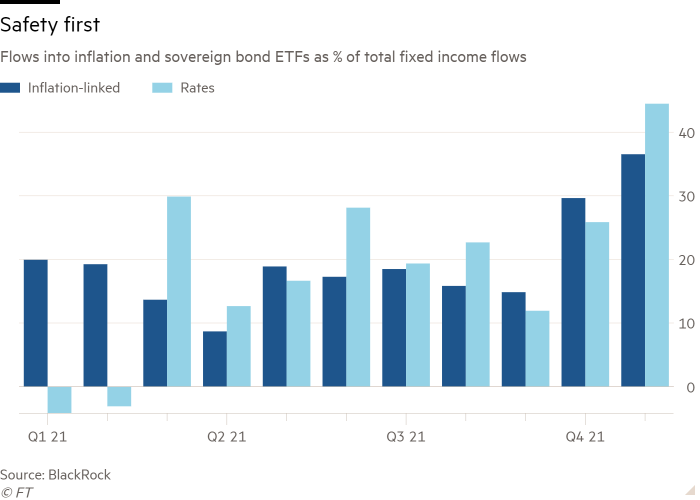[ad_1]
Interested in ETFs?
Visit our ETF Hub for investor news and education, market updates and analysis and easy-to-use tools to help you select the right ETFs.
Investors are turning their backs on bond exchange traded funds amid worries over inflation, with inflows slumping to their lowest level since the start of the Covid-19 pandemic.
Bond ETFs saw global net inflows of just $14bn in November, according to data from BlackRock’s iShares arm, the weakest reading since March 2020, when markets were upended by the emergence of the novel coronavirus.
Many traditional corporate bond and high-yield bond ETFs will have fared worse still, with investors increasingly looking to protect themselves from the ravages of rising prices via inflation-linked bonds or short duration government debt, iShares found.
An unusually high 37 per cent of fixed income flows went into inflation-linked bonds in November, while sovereign debt funds — often focused on China — took in a further 44 per cent, leaving corporate bonds, especially high-yield ones, out in the cold.
“[There has been a] change in mix towards rates [sovereign bonds], inflation-linked and China [government bonds],” said Karim Chedid, head of investment strategy for iShares in the Emea region. “We see them continuing to be important drivers in 2022 because of the need to hedge for inflation and to search for income.
“Investors are expressing a preference for shorter term duration,” while corporate bonds “have seen a slowdown in buying and high yield has seen some outflows,” said Chedid, although he said there were signs of Europeans starting to buy the dip in corporate bonds in early December.

“It has been the year of equities,” said Jose Garcia-Zarate, associate director, passive strategies research at Morningstar.
“[There have been] a few flows into fixed income markets, mostly directed into inflation-linked and short-term debt in anticipation of central banks actually hiking rates in 2022. There is very little value in developed fixed income markets,” added Garcia-Zarate.
China has been an exception to the general gloom in sovereign bond ETFs. “There has been a further opening of the Chinese bond market to international investors. It has become a very attractive place to be, simply because of the yield that they offer in comparison to developed markets,” he said.
“There is good credit quality. You know the Chinese government is going to pay you back. Broad emerging market bond indices have lost money this year. China has made a substantial amount of money.”
Some ETF providers have benefited from this trend with the $12.1bn iShares China CNY Bond Ucits ETF (CNYB) becoming the second-largest fixed income ETF in Europe just two years after its launch.
Matthew Bartolini, head of SPDR Americas research at SSGA, agreed a rotation was under way characterised by outflows from traditional corporate and high-yield bond ETFs to US Treasury inflation-protected securities (Tips), which saw their second-highest ever monthly inflows in November, beaten only by October, and to ETFs specialising in senior loans, which are floating rate and rank high in companies’ capital structure.
However, Bartolini noted that fixed income was still “on track to have over $200bn of inflows this year. That would be the second consecutive year and this has never happened before.”
Data from ETFGI, a consultancy, pointed to net inflows of $211bn into bond ETFs in the first 11 months of 2021, in line with last year’s record, although a fraction of the $789bn that equity ETFs have attracted.

Click here to visit the ETF Hub
[ad_2]
Source link

